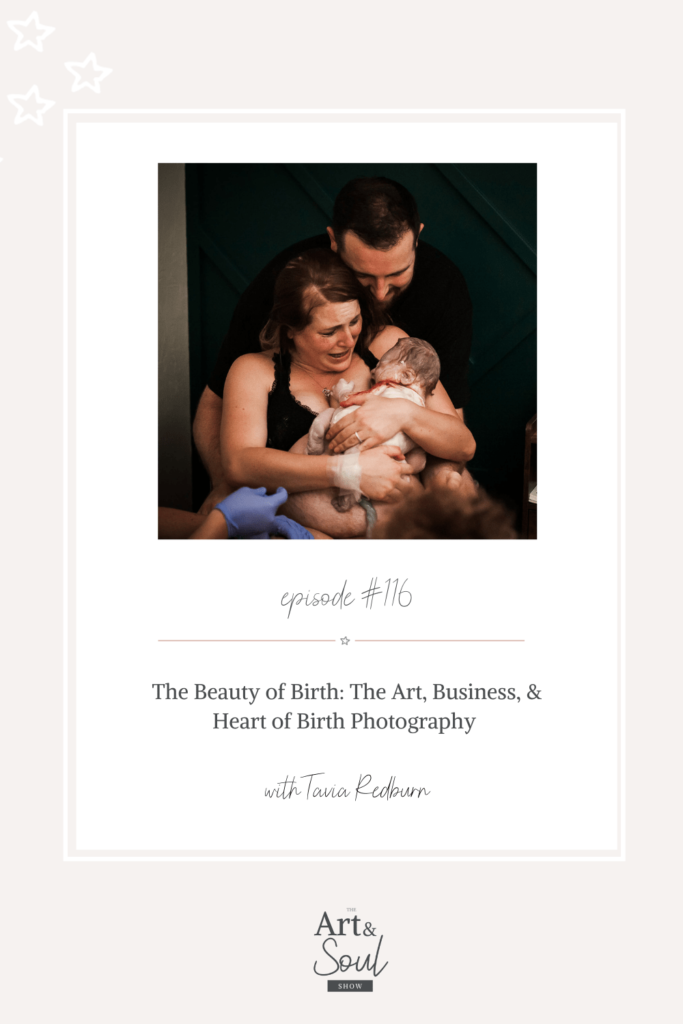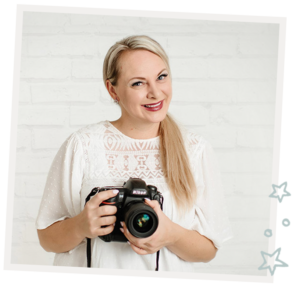The Beauty of Birth: The Art, Business, & Heart of Birth Photography with Tavia Redburn
In the photography world, there are few fields more intense and emotionally demanding as birth photography. You’re responsible for capturing a baby’s first moments of life and a couple’s first moments of parenthood. And in order to be there for those moments, you have to make adjustments in your own life. It’s taxing, it’s demanding, but it’s also incredibly rewarding.

In this episode, I’m chatting with birth photographer and photography educator Tavia Redburn about balancing her personal life and mental health with an emotionally demanding business in the field of birth photography.
Tavia is sharing her process for communicating with clients and making arrangements for births. She’s explaining how she plans for and prices her services, and she’s also sharing her advice for protecting your energy while photographing such intense, emotional moments.
What’s in this episode:
- Tavia’s unconventional path to becoming a birth photographer and photography educator [2:07]
- How to balance your personal life and family’s needs with a birth photography business [3:33]
- What happens when a birth doesn’t go as planned [6:09]
- How to best communicate with your local hospitals and birth community [8:05]
- How to protect your energy and take care of yourself in a high-intensity field [9:50]
- Tavia’s stories from your career as a birth photographer [14:30]
- How Tavia communicates with her family and childcare when births take longer than expected [16:00]
- Tavia’s advice for shooting in terrible hospital lighting [16:41]
- How to plan for a birth and what to do if you miss a birth [18:01]
- Tavia’s funniest and most fun birth experiences [20:59]
- How to price yourself for profit and sustainability in an emotionally taxing field [23:40]
If you’re curious about managing a birth photography business, tune into this episode.
SUBSCRIBE: iTunes | Spotify | Stitcher
Resources Mentioned
Digital Minimalism by Cal Newport
Lisa’s book suggestions, Hooked, Building a StoryBrand, and Contagious
Meet Tavia Redburn
Fueled by equal parts black Americano & sparkling water, Tavia spends her days helping students worldwide learn how to become certified birth photographers + learn photography marketing strategies so they can go full time. She’s been photographing births at Tavia Redburn Photography since 2012. In 2017, she created The Beauty in Birth program to help other photographers follow her marketing systems to create the birth photography business of their dreams!
Connect with Tavia
If you enjoyed this episode with Tavia about her life as a birth photographer you might also enjoy this episode from Kristen Cook
Transcript:
[00:00:00] Tavia Redburn: We just have to go back to our responsibility as birth photographers, which is to tell the client’s story however that unfolds. And they’re going to be so thankful, even with the change of plans, that they have these photos, maybe even more so because it helps them process everything that happened. So we have a really important job to show up as emotionally unattached as we can so that we can do a great job for our clients.
[00:00:28] Lisa DiGeso: Welcome to the Art and Soul Show, where we dove into heart opening chats on photography, business, life and that messy in between. I’m your host, Lisa de Jesus, a mom, a photographer and entrepreneur. And I’ll be sharing honest conversations and advice for photographers with insight on mindset, entrepreneurship and creativity. The goal of this podcast is for you to be able to gain insights and strategies that will get you real results. Because, let’s face it, having a photography business can be lonely, but it doesn’t have to be. This is the place you can go when you need a boost of encouragement, a kick in the pants and inspiration to pick up your camera. This is the Art and Soul Show. Hello, my lovely friends, and welcome back to the show. So today I’m hanging out with Tricia Redburn. She is an incredible photographer and educator that I first discovered on Tik Tok, of all places. We were both part of a social media marketing Facebook group, and I was so excited to find a new friend in my industry. She’s a photographer, photography educator with The Beauty in Birth. She trains both photographers to be the best in the industry with her certification and marketing programs. And she’s the host of the From Better Half to Boss Photography Podcast, and she’s now also teaching for us for the Milky Way 2022 Online Newborn Retreat on Birth Photography. I was a guest recently on her podcast. I knew I had to bring her on this show and share her with you. So without further ado, here’s to you.
[00:02:00] Tavia Redburn: Hi, Lisa.
[00:02:01] Lisa DiGeso: Welcome.
[00:02:02] Tavia Redburn: Thank you so much. I’m so excited to be here and chat with you about all things birth photography.
[00:02:07] Lisa DiGeso: So tell us who you are and what you’re passionate about.
[00:02:10] Tavia Redburn: Oh, okay. What I’m passionate about. I love that. So my name is Tavia Redburn. I’m a birth and newborn photographer in Oklahoma City, and I became a birth photographer in 2011 when I hired a birth photographer who didn’t show up for my son’s birth. And I decided that I wanted to be someone reliable that my community could count on. So I photographed my very first birth in January 2012 and haven’t looked back since we started a certification for birth photographers to just sort of level up the industry in 2019 was when we very first started doing that. So now we help hundreds of photographers all over the world learn birth photography and how to get certified as a birth photographer.
[00:02:51] Lisa DiGeso: I love that. So when you first got started with photography, did you know birth photography was like your niche that’s where you wanted to just be or did you like to start with all of the things too?
[00:03:01] Tavia Redburn: I totally started with all of the things. I just kind of dabbled in everything just to see what I was passionate about. And when I photographed my very first birth, I was just hooked. I was like, How can I do this again? It was just like a no brainer. It instantly became like, This is what I know I want to do.
[00:03:19] Lisa DiGeso: I love that. That was like me and newborns like posed newborn photography. Like, that was my jam from day one. And even though I was horrible at it, I just loved it so much. So totally. I totally get following your heart. So let’s talk a little bit about scheduling and childcare and birth photography, because I think for many photographers, even considering adding it into their roster, it can feel a bit daunting and overwhelming. So how do you handle it and what advice do you have on that?
[00:03:49] Tavia Redburn: Yeah, for being on call, it can definitely feel overwhelming. I think that communication is key with all parties involved. So just over communicating that you’re not sure what’s going to happen. You don’t really have to know when the baby’s going to be born. Right. And so I think that over communicating with your clients to say, hey, please let me know when you think labor is starting, please keep me updated on what your doctor or midwife is saying about when you might go into labor. You’re communicating that over the top with your on-call, child care and people in your life who might take care of your kids when you get called to a birth. And so it can feel a little chaotic in the beginning because you’re like, I’m on call from 37 weeks until 40. You know, that’s so long. But the reality is it’s a short period of time where it’s actually kind of a go time. A lot of that in between is just communicating with the client, communicating with your child care, like, hey, I just heard from her. She said that she might, you know, labor might be starting out. And so you touch base with your child care in that way and just keep everybody in the loop. So just over communicating is key and getting a detailed birth history from your client, if they have one, to know what their previous labors were like. How many weeks were you when you went into labor? How did your labor start? How long did you push? All kinds of things like that so that when they go into labor, you have that reference back to you and you can say, okay, so they’re 38 weeks. They told me the last time they were 38 weeks in was when their labor started with their water breaking. She just told me her water broke. Like you can start to see similarities. And so understanding birth is really important when it comes to the on-call side of things.
[00:05:25] Lisa DiGeso: Yeah. And probably even understanding the stages of birth. And like and being aware of how things can either progress really fast or also progress really slow.
[00:05:34] Tavia Redburn: Absolutely. And I think that being aware of birth physiology and that if mom goes past a certain due dates is the doctor are going to try to do something like if they go past 40 weeks, are they going to induce or if she’s been in labor for a certain period of time, are they going to start looking at C-section? And some of that stuff is just experience with different providers and different hospitals and understanding like what the family’s birth plans are. So, you know, like they really want to avoid induction so they’re probably not going to do that or they’re planning on getting induced. And all of that just comes from conversation before birth.
[00:06:09] Lisa DiGeso: Yeah. And I think even like I had so many clients that have had an emergency C-section and like what happens in that scenario? Does the birth photographer get to come in? Are they no longer in the birth and able to photograph it? So what happens in that scenario in your area? And what advice do you have on that?
[00:06:28] Tavia Redburn: Yeah, good question. So before COVID, I knew certain hospitals would allow me into the O.R. and certain hospitals wouldn’t. And so I think that just becoming familiar with the places that people are giving birth in your area, becoming familiar with the providers involving yourself in the birth community so that, you know, other birth workers is really helpful because sometimes stuff changes, especially with COVID, right? Like, you know, you never know. For the last two years, it’s been so back and forth of like, oh, two people are allowed in. Three people, one person, no people. And it totally depends on your area. So as far as an emergency C-section goes or any C-section for that matter, it’s really up to the provider and the hospital and knowing their policies. And so that’s one thing that we go over in the consultation with the client is like, hey, I know you’re not planning on a C-section, but really quickly, let’s talk about what that looks like if that does happen. And so we’re talking about all of those things ahead of time so that if they do happen, they don’t feel like they’re slighted or that they got the short end of the stick or something like that. Like it’s like, hey, this is what we talked about. So here’s what we’re going to do since you had a C-section and I wasn’t allowed in. And a lot of times for us that would look like a fresh 48, that we would come back to the hospital and do or I would come up, photograph everything right before and everything right after. And really that is so much of what people love about birth photography anyway. Yeah. So I think it’s really all about determining what you as the photographer are going to do in those unexpected situations and you taking the initiative to say if you have a C-section, here’s what we’re going to do and the client knows ahead of time what to expect.
[00:08:05] Lisa DiGeso: Yeah, I love that. I think there’s a real fear for many photographers working with hospitals and finding out what is allowed and what isn’t allowed. So how would they go about finding what is permitted in their local hospital?
[00:08:17] Tavia Redburn: Yeah, you can for sure call them, but sometimes you’re going to get different answers depending on who you talk to. So I think the best thing to do would be one of two things. Number one, getting involved in your birth community, chatting with doulas and others.
[00:08:28] Lisa DiGeso: Birth workers.
[00:08:29] Tavia Redburn: Who already kind of knows the hospital policies and what is typical for different facilities, as well as chatting with your client or potential client and just saying like, hey, I’m actually unfamiliar with this hospital or this birth center. Do you know what they allow or can you ask your doctor what their photography or videography policy is? I kind of like the birth worker route myself because it’s kind of like inside knowledge. But calling the hospital honestly is like number three on my list because it really just depends on who you talk to. What? That’s so.
[00:08:57] Lisa DiGeso: True. It’s so true. It’s like nurses to you, unfortunately. What’s your plan? So see, for example, you’ve got a client that’s having a homebirth and ends in hospital and I’m sure that that happens. It’s happened to a number of my clients from experience to how do you pivot?
[00:09:12] Tavia Redburn: I follow them. Yeah.
[00:09:14] Lisa DiGeso: You go. Are you getting in the car with them?
[00:09:16] Tavia Redburn: Not typically. Typically, I’ll jump in my car and just follow them to the hospital. And it kind of mostly depends on if it’s like an emergency situation or if it’s a precautionary situation. So I’ve had both happen to where it’s like, drop what you’re doing, we’re going right now. Or I’ve also had it be like, Hey, things aren’t looking like we want and so let’s start making our way to the hospital. So those are two different situations, but whenever I possibly can, I’m following them wherever. So I don’t pack up my gear. I have my camera around my neck, grab my stuff, follow them to the hospital and keep shooting.
[00:09:50] Lisa DiGeso: So what I really underwrote I have so I photographed literally one birth and that was for my business partner. And it was funny because after my son was born, I remember my husband laying down in the chair and I’m thinking like, What the hell, dude? Like I just went all through all the work and you’re sleeping well after that situation. In that scenario, I went back like she had a beautiful, like, almost £10 baby that she delivered in under 3 hours. Like, it was so fast. I went home and slept for, like, 17 hours straight. I was, like, exhausted. So I had a new appreciation for what the partner goes through. So how do you mentally and physically and emotionally prepare yourself? Or what you go through as a birth photographer and like plan B, your best times, too?
[00:10:33] Tavia Redburn: Yeah, that’s such a good question because I think that protecting our energy as photographers, as business owners, especially if you also photograph portraits like what does that look like? How are you protecting your energy for, you know, your other clients? And I think that what often happens is those first 5 to 10 births are unique in that chances are this is the first time you’ve seen somebody else give birth. It’s very emotional and rightly so. You get to a point in birth photography, too, where it becomes what you do. You know what I mean? Like the first time you photograph a newborn are the first five or ten times. It’s very different once you start to do it more frequently. Yeah. And so I think that not that the emotion leaves, but it just changes and you start to shift into like, I have a job to do here, I have a client to serve and I have something that I need to do. And it just becomes naturally, at least in my experience, less emotionally exhausting the more that you do it. It’s the same kind of thing when photographers are like, How do you not cry at every single birth? Like, I just want to cry the entire time. It’s so beautiful and it’s like, it is so beautiful. And I did cry for the first like five or ten births the whole time. And then it starts to become like, okay, I have a client, I have a, I have a mission, I have a goal that I’m accomplishing for that client. And it starts to not lose emotion. It just changes.
[00:11:53] Lisa DiGeso: You can almost attach a little bit from it. I do. I have found that over because I love my newborns. But there’s some sessions where I’m like, I’m not like, this is my job, it’s my job. And I know how to do it very well. And there’s sometimes I’m just like, I look into these newborns and I burst into tears, like, so it’s so funny. It’s so funny, but it’s so true. Like, in order to get through it, you do. You do have to sometimes emotionally detach a little bit in order to do our job.
[00:12:18] Tavia Redburn: And it’s the same to you when there are outcomes that are different. So especially if it’s an outcome that you experienced as a mom yourself. So like I’m vbac mom, vbac are very near and dear to my heart. So whenever I have a vbac mom, I’m always very protective of her mental state and like, I don’t want to say C-section to her because I know what that’s like and like. So it definitely hits me differently for moms that have gone through what I have gone through. And not all births have the intended outcome, like, Oh, I’m planning on a vbac and I end up with a repeat C-section, or I’m planning on a vaginal birth and I end up with a C-section or whatever homebirth transfer. And I think that, again, we just have to go back to our responsibility as birth photographers, which is to tell the client story however that unfolds. And they’re going to be so thankful, even with the change of plans, that they have these photos, maybe even more so because it helps them process everything that happened. So we have a really important job to show up as emotionally unattached as we can so that we can do a great job for our clients.
[00:13:24] Lisa DiGeso: So I love that because I didn’t really realize that. But you were so right. I’m an IVF mama and so my IVF clients are so near and dear to my heart. Like, those are my people. So it’s, it’s, it’s interesting. Like when you, when you work from experience. I love that. I love that you touched on that because I actually hadn’t thought about that. And I was like, Oh, my goodness, I do do that.
[00:13:45] Tavia Redburn: Do you find that your ideal client is an IVF family?
[00:13:50] Lisa DiGeso: Actually, I think so, yeah. And I actually didn’t even realize that like that because we just share stories. I share what they’ve gone through and I’ve shared the years of infertility and how thrilled and excited they are to be at that session and how present they are. And it is such a gift and I love that so much. And so it’s just a different experience for me in those sessions to connect with them too. And that’s what I am really passionate about. So I think you just found I just figured out where I’m rebranding.
[00:14:22] Tavia Redburn: Just amazing. Well, you know, I can’t help talking about marketing if I can ever hope to. And I’m like, let’s talk about marketing zero.
[00:14:30] Lisa DiGeso: I love it. I love it. So I have to ask, what is the longest birth I’ve experienced?
[00:14:37] Tavia Redburn: Oh, girl, it’s always my goal. To be there in active labor is what I tell my families. I’m like, back in it, way up for you to be there in active labor. And so I had a client tell me she was planning a homebirth. It was her first baby and she was seven centimeters. Contractions were coming every I want to say 3 minutes lasting 45 seconds. So those are all things that I’m asking my clients because especially in a homebirth situation, when you’re not getting your cervix checked, it’s like, okay, well, she she was, but a lot of homebirth clients don’t. So you kind of have to go off of other signs that they’re in active labor. So her contractions were close, they were long. And I show up, she’s seven centimeters. I’m cool. We’re having this baby in the next few hours. I was there for 36 hours now and don’t feel sorry for me now. I mean, like, she was amazing. I’m sure she wouldn’t want you to feel sorry for her. I am also a mom who had really long labors, so I just empathize. So I was there for 36 hours and it was just one of those things that was unavoidable. I showed up actively, but I wasn’t there too early. She was just progressing like one centimeter every 8 to 10 hours and pushed for like 5 hours. And so there are those outliers that you kind of do everything right as far as when you go, and they just have a lot. Everything was fine. Everybody was healthy. She just had a big old baby.
[00:16:00] Lisa DiGeso: And so how do you pivot and like to let your family know and plan that you’re just taking longer than expected? Like, how does everybody roll with that?
[00:16:08] Tavia Redburn: Really? Well, just.
[00:16:10] Lisa DiGeso: Good.
[00:16:10] Tavia Redburn: Really well. I just keep them updated, like in the same way that my client would keep me updated. I say, Hey, she’s eight centimeters now. Hey, she’s ten centimeters now, kind of a thing. And my husband would bounce between like dropping kids off with my mom or his mom or whoever else that we needed to. And he would go to work when he worked. He’s a stay at home dad now, but when he was working, that’s what would happen. And kids were just kind of bounced between people. So it’s few and far between like those. Those real long ones do happen. But I would say the average is more like 6 hours that I’m there total.
[00:16:41] Lisa DiGeso: I love that. So let’s face it, there is some serious horrible lighting in hospitals, especially hours. So what advice do you have for getting around really bad lighting?
[00:16:52] Tavia Redburn: Yeah, that is so true. Speed light. And I know that that is a little used to be controversial in birth geography to say that you would use a speed light. Now it’s a little bit more widely accepted than it used to be. But I always tell my clients I want to be a fly on the wall. Like I want to just capture everything as it’s happening. I don’t want to be in the way. I’m not going to speak unless spoken to kind of a thing. Like me, I don’t want to be involved. Like, I’m here to take photos, but then I’m busting out a flash, right? And it’s like, okay, it’s hard to be a fly on the wall when you’re using the speed light. So I just had an extensive conversation with him. I’ll just explain what my flashes are like. It lights up the whole room. It’s not a pop up flash. It’s not directly in your face. It bounced off the wall. So it really just lights up the whole room. And I always tell them, if at any point that bothers you, let me know and I’ll stop using it. No one has ever asked me. Out of 150 births, no one has ever asked me to stop using it. They don’t care. And I think that we as photographers, birth photographers, birth workers specifically think more about that than they do. So most of the time, clients don’t care. So I create my own light and I actually rarely use natural light. I pretty much rely on it for the whole birth.
[00:18:01] Lisa DiGeso: Yeah, that’s good. So I think there’s also this fear of committing to a client and then missing the birth. So can you share how to plan and get over that fear and how you address that when maybe it happens?
[00:18:12] Tavia Redburn: Yes. So it goes back to that in-person consultation before they give birth, really getting a detailed history, labor history, when to call you. And I always call that my you’re not going to bother me meeting because I think that families sometimes feel like when they’re updating me in early labor that they might be bothering me like, oh, it’s not serious, I’m not going to text her or, Oh, my contractions are only every 5 to 10 minutes. I’m not going to text her. So I always say, you’re not going to bother me, and I would rather have too much information than not enough. And so please don’t feel like you can’t text me. So I just reinforce that to them. Because the times that I have missed a birth, it’s because the client has told me too late because they kind of were in labor denial and pushed it off and pushed it off until it was too late. So that’s the first thing. The second thing is I ask the client for 2 hours to get to them from when they tell me to come to when I arrive. And so when I put it to them that way and I say, Hey, when you say tardy, it’s time to come, it’s going to take me 2 hours. They start to realize like, okay, I really need to give her enough notice. And it happens. I think out of 150 plus births, I’ve missed 5 to 10. Yeah. So it does happen usually just with a precipitous labor that’s just super, super fast and sometimes even the doctor doulas miss. And so in that case, I chat with them ahead of time and say, if on the off chance I miss your birth, I will come back and we’ll do a fresh 48 session, get everybody meeting the baby, that kind of thing. So again, communicating expectations, talking about all of the what ifs ahead of time. That way, the client doesn’t feel like they’ve lost out on anything if plans change. And I also don’t get a refund if I miss the birth. So that’s why we talk in detail about what that looks like.
[00:19:55] Lisa DiGeso: Yeah, I love that. Now do you also fit your birth clients? I fresh 48 as well. And how do you plan that?
[00:20:01] Tavia Redburn: Rarely. So a lot of times we just will capture the kind of fresh 48 type things immediately after birth. But if they specifically want to add it on we do something that we started doing during COVID I don’t know if I’ve told you about this coming home sessions so we will meet the family at the hospital, follow them home, capture them like bringing a baby and meeting grandparents. Meeting siblings like settling into the nursery and that. It came because of COVID. It was like, well, we can’t get into the hospital. And so what else can we do to kind of give people the next best thing? And we created a session out of necessity, which was coming home sessions.
[00:20:40] Lisa DiGeso: I love that so much. I love that so much. It’s like I wish there were more of was first step sessions right like place.
[00:20:48] Tavia Redburn: For 1 year old.
[00:20:49] Lisa DiGeso: Yeah. Instead of letting you flash like, first steps because it really happens, like, you kind of know what’s going to happen within the next week, right?
[00:20:55] Tavia Redburn: Mm hmm. Yeah. I love that to be fun.
[00:20:59] Lisa DiGeso: So can you share your funniest birth story?
[00:21:02] Tavia Redburn: Oh, funniest. I love gender surprises. Like when they don’t know the sex of the baby and they see for the first time. Like, those are always my favorite. I’m trying to think about the funniest, though.
[00:21:14] Lisa DiGeso: Or even like a siblings reaction.
[00:21:17] Tavia Redburn: Or oh man, sibling reactions. Okay. So my favorite moment is the I did it moment, like when she sees her baby for the first time. That is my absolute favorite moment. And my second favorite is sibling reactions like the sibling seeing the baby holding the baby, like the cute things that they do and say, that is my absolute favorite, gosh, funniest moment. I can’t think of anything off the top of my head, but I think gender surprises are so fun and getting other family members involved. One time I had a family who knew the sex of the baby themselves, but they weren’t telling the parents, her parents or the grandparents. And we got photos of her putting a little pink hat on the baby and they came in and she took the blanket off and they saw the pink hat and like their reactions for the first time, like that kind of stuff is just priceless. And it’s just like, I just want the world to know about birth photography so they don’t miss out on those moments because there’s such, like there’s so few moments in life like that. And when you get to have professional photos of those so that you can truly relax and be in the moment and not have to worry about taking photos, it’s just really unlike any other genre of photography or moment in your life.
[00:22:23] Lisa DiGeso: It’s so true. I remember I did that with my mom, with Erin, my business partner, when her parents came in, and they’re both tearing up. I kind of like still shooting because I’m like, I’ve never done this before. And, oh, I was crying. They were crying. It was so beautiful. But it also reminds me, it was like whenever I go to the airport and you go to the arrivals, I’m always there extra early. And for some reason, the plane is always light. People coming through, arrivals that are so happy to see each other. I sit there and I hold back tears every time I sit in arrivals and it’s like those moments that just hit your heart like, oh, if you can hire somebody, capture that. Yes, yes, yes, yes, yeah. Birth photography for everyone.
[00:23:06] Tavia Redburn: And you can be in the moment, you know what I mean? Like your friend Erin, she didn’t have to sit there and try to fumble with her camera and get her parents meeting the baby. You know what I mean? She just got to sit there and really enjoy it and also have photos.
[00:23:18] Lisa DiGeso: Yeah. And do you do video as well? Yes, with that, too, isn’t it? It’s so powerful.
[00:23:24] Tavia Redburn: It really is. And I did it for a long time until I had a videographer at my daughter’s birth and I was like, okay, I have to start offering this because photos are fantastic and video really just takes it to the next level to where.
[00:23:35] Lisa DiGeso: You can really.
[00:23:37] Tavia Redburn: Hear the sounds and see the movement and all of that stuff.
[00:23:40] Lisa DiGeso: It’s just beautiful. So taking into consideration how birth photography will affect you emotionally, mentally and physically. Do you factor this into your pricing?
[00:23:49] Tavia Redburn: Yes, absolutely. Yeah. And I wouldn’t be able to give you a number. It’s more of the fact of like, how many can I take per month, not only for the on-call time, but also for recovery time and like all the things that we’ve talked about. And so once you can set that number and know how much you need to make per month, that can help you start to figure out what to charge. But yeah, definitely you’re on call time on the emotional side of it for sure. Need to be factors when you’re putting out your pricing and birth photographers tend to be so passionate that they just and all photographers that they just want to like do it for free or do it for $100. But whenever you can really take into account longevity and do you want to be doing this for a long time, you have to understand that after the first five or ten, it might wear off a little bit and you need to be compensated well for those things that you’re doing to not only yourself, but your family and sacrifice for somebody else.
[00:24:43] Lisa DiGeso: Well, I find it so fascinating because like there’s an industry standard of wedding photography where it ranges upwards of two, 3000, four or 5000 up to, like, infinity. Really? Mm hmm. Whereas birth photography, you’re at something just as long, just as intense. And yet it’s not looked at, not typically viewed as something that wouldn’t be in that same price range. So I’d love to talk a little bit about pricing yourself because there is so much that goes into it. So how can photographers start to figure out how to price themselves to be profitable and sustainable?
[00:25:15] Tavia Redburn: Great question. What I did is I looked at how many clients, birth clients can I take per month or even for the whole year because I like to take two months off call. So if you say, okay, I can. Take three clients per month with two months off call. That is 30 clients a year. Okay, well, how much money do I need to make not only in my business, but to pay myself a good salary? I am a full time photographer doing that many births, right? So how much do I need to pay myself and my business? And once you have that number, you can just divide that by the number of births you’re doing. Now, one thing to consider, what we do is specialize in birth photography, and we have a process to upsell clients on maternity, newborn, baby playing sessions. So we look at births like the wedding, like the big event that they’re hiring us for, and like a wedding photographer would then go on to upsell, boudoir, engagement, those kinds of things. It’s similar for us as birth photographers. So then I can say, okay, what does my average client spend on those additional sessions? So now I know if I can make $5,000 on each client that starts as a birth client, that turns into a six figure photography business with those 30 clients. So I kind of like to start with the end in mind. How many can I take? How many do I need to run a profitable business? And kind of backtrack it that way.
[00:26:38] Lisa DiGeso: Yeah, I love that. So you ready for the lightning round?
[00:26:42] Tavia Redburn: Oh, yes, I’m ready.
[00:26:44] Lisa DiGeso: Coffee or tea?
[00:26:45] Tavia Redburn: Coffee. 100% coffee.
[00:26:48] Lisa DiGeso: Last series you binge watched.
[00:26:51] Tavia Redburn: Oh, my gosh. You would ask me this. I hope that somebody out there has watched this show. We’re currently binging Naked and Afraid.
[00:27:01] Lisa DiGeso: Oh. It is my life. We watch this so much that we like my son. Okay. When he was like eight, I had this prop bag and he came out wearing only the prop bag, mimicking Naked and Afraid so. Okay.
[00:27:14] Tavia Redburn: I love you even more.
[00:27:16] Lisa DiGeso: I am your person.
[00:27:17] Tavia Redburn: Right?
[00:27:19] Lisa DiGeso: I’m grateful from my bed. So grateful for the food and my bed.
[00:27:23] Tavia Redburn: Glad so true. I feel so guilty when I’m, like, eating a snack while watching that show. I’m like, I’m so sorry that you’re eating a bug the first meal you’ve had in 15 days. I’m so glad, Lisa, that you’ve watched that show because whenever we came across it, I was like, I don’t know what this is, but I want to watch it. So we watch an episode every single night.
[00:27:41] Lisa DiGeso: I love it. It is so good. Yeah, we love that. We would download it and take it on our vacation and watch it huddled together on a laptop like we loved it that much.
[00:27:52] Tavia Redburn: I love it. It’s so good. We’re only on the first season, so I hear that it gets better as.
[00:27:57] Lisa DiGeso: It gets better. Yeah, I hear it. I love it. Favorite book.
[00:28:01] Tavia Redburn: I love reading the book. Digital Minimalism by Cal Newport. Have you read that one?
[00:28:06] Lisa DiGeso: I haven’t. I’ve heard of it, though.
[00:28:08] Tavia Redburn: It is not a business-y book, but I kind of turned it into a business-y book because it applies to so much of your life. So that is a book that I have read more than once. I’m not a big fiction reader, so I love nonfiction. I would say digital minimalism.
[00:28:22] Lisa DiGeso: Check it out. Favorite indulgence.
[00:28:25] Tavia Redburn: I love candles. I love expensive candles. So I would say that would be an indulgence. Magnolia brand candles. To me, those are expensive. Like when I order them off of her website, I’m like, This is expensive, but this smells so much better than the ones from Target. So Magnolia candles are my favorite indulgent.
[00:28:43] Lisa DiGeso: I love it. I actually have my husband. I’m no longer allowed to use candles in my house because I forget to blow them out like I am a fire hazard. So what I got for Christmas was they had these, like, sets of LED candles, like, it was like a set of six for 40 bucks. I bought eight sets. They are all over my house now and I have them with my remotes. And so. So he’s like, he’s like, this is good because now you can’t set the house on fire. But we go through so many batteries.
[00:29:13] Tavia Redburn: I love that you have a remote for it.
[00:29:16] Lisa DiGeso: I just sent you a picture. I love it. Like they’re everywhere. Every. I love it.
[00:29:20] Tavia Redburn: That’s so good. I love it.
[00:29:22] Lisa DiGeso: Most exotic place you’ve ever traveled.
[00:29:27] Tavia Redburn: Ooh, Bermuda. We went to Bermuda, which is just out in the middle of the ocean all by itself. But it is like the most beautiful beach I have ever seen. My husband and I traveled on little mopeds. This was pre-COVID. I don’t know if the island is shut down or what, but little mopeds, we traveled around the island just exploring and it was such a fun adventure.
[00:29:47] Lisa DiGeso: I love that. That’s fun. What do you wish more photographers knew?
[00:29:50] Tavia Redburn: I wish more photographers knew that they can be full time, that photography doesn’t have to be a hobby, that if you want to go full time with photography, that you can make real money doing something that you love.
[00:30:04] Lisa DiGeso: What lights up your soul?
[00:30:06] Tavia Redburn: Being outside. Being outside with my family. Doing something adventurous. We love hiking. We love bike riding like new places. And my kids are old enough now to do those things. And so I love being outside with my family, exploring new places.
[00:30:21] Lisa DiGeso: I love it. What’s your go to karaoke jam?
[00:30:26] Tavia Redburn: That’s so funny that you ask that. Because it’s totally Shallow from A Star Is Born.
[00:30:32] Lisa DiGeso: God.
[00:30:32] Tavia Redburn: Why do you know that? Yes. Yes. My daughter has. I would game you. Okay, let’s do it. Yeah. My daughter has an iPad piano game, and she knows how much I love that song. So she, like, saved up her coins. And yesterday she was like, Mom, I bought you Shallow on the iPad, so you can play it. I know. Isn’t that so sweet? She knows how much I love that song.
[00:30:56] Lisa DiGeso: Oh, I love that. So where could our listeners learn more from you?
[00:31:00] Tavia Redburn: Yeah. So I have a podcast called From Better Half to Boss Photography podcast, where we talk all things birth photography, but also business and marketing and how you can go full time if that’s something that you want to do and all about how I retired my husband from his 9 to 5 with my photography business also on Instagram @_thebeautyinbirth_.
[00:31:20] Lisa DiGeso: So I love to end my interviews with this last question. And it is what are you curious about or artistically curious about?
[00:31:28] Tavia Redburn: Who am I curious about? I think I absolutely love learning about marketing. I know that sounds so lame, but I love data and learning like why our human brains make the choices that we make and like why we buy and why we don’t buy. And marketing persuasion techniques and like copy and messaging. I could literally geek out on that stuff for forever. And so I love business and marketing like a giant dork.
[00:32:02] Lisa DiGeso: Meet you. Have you read hooked or no. You need to get hooked and the story brand.
[00:32:08] Tavia Redburn: Yes, I have read the story brand. I’m writing down hooked.
[00:32:11] Lisa DiGeso: And I think there’s another one called I think It’s Contagious.
[00:32:14] Tavia Redburn: By Jonas something. Yeah, yeah. I read that a few years ago, but I could definitely read it again.
[00:32:19] Lisa DiGeso: Yeah, I have two hobbies. One is reading books and I get about 100 pages and then I pick up a new one and the other one is buying books. So I love books.
[00:32:28] Tavia Redburn: But I am with you on that. And I think that we need to just start giving ourselves permission to jump around in books like, Hey, Lisa TV, it’s okay if you don’t read the whole thing, like it’s okay.
[00:32:38] Lisa DiGeso: You can come back to it any time you don’t have to, you know, you don’t have to finish everything on your plate. You don’t have to finish a book. It’s fine.
[00:32:45] Tavia Redburn: 100%. 100%. I want to. Can I ask you, Lisa, what’s something you wish more photographers knew?
[00:32:52] Lisa DiGeso: There’s not one way to run a business. It’s what aligns with you, what feels right for you, and that it’s okay to go your own way. Yeah, that would be my advice. I love it. You’re asking that no one’s ever done that.
[00:33:05] Tavia Redburn: I wanted to ask you all of these, but that would have been a little obnoxious, right? Have you ever answered all the lightning round questions yourself?
[00:33:12] Lisa DiGeso: Um, I don’t think I have.
[00:33:14] Tavia Redburn: Oh, you have to do that sometimes. I want to hear your answers.
[00:33:18] Lisa DiGeso: I love it. Well, thank you for joining me today. This has just been such a fun time chatting with you.
[00:33:23] Tavia Redburn: Thanks so much for having me. It’s been a blast.
[00:33:27] Lisa DiGeso: Oh, my friends, I loved that conversation so much. So if you are interested in getting started with birth photography, I will make sure that we know where to send you to go find Tavia. I am sending you so much of my light and my love today and every single day. Thanks for showing up and we will see you next time.
share the love
[Sassy_Social_Share]
recent
Podcasts

I'm
Lisa DiGeso
I’m on a mission to create uplifting online experiences for photographers ready to elevate their art, their business and their mindset.(...and have fun along the way!)
























